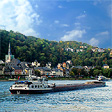GERMAN
FAST ICE TRAIN
DB Intercity-Express – Germany’s High Speed Rail
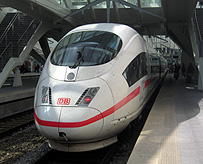 Okay,
so I recently got messed up by a European low cost airline who
couldn’t manage to find a crew to fly a plane from Brussels
to Berlin, leaving me stuck at the airport with appointments the next
day. Luckily, I had a free day left on a Eurail Select Pass. It would
be faster to take the ICE from Brussels to Berlin than wait for the
next available airplane seat. Its
initials are distinctive and somehow suggestive of its purpose, the
German ICE train, (Germany's Bullet Train) is much like a jet plane, except you get to see
scenery out the window. The letters stand for Inter-City Express, which
distinguishes the class from the IC - InterCity and the EC – Euro
City trains which are the standard national route express trains. Local
routes trains are RE – Regional and some various other distinctions.
Though if you pronounce it like the frozen water that goes in a highball
glass, you’ll get an odd look. It’s pronounced as separate
initials – I-TSE-AE. The German National Railway – the
Deutsche Bahn or more familiarly just the DB, began its high speed
rail service in 1991 with the introduction of the special purpose engines
of sleek aerodynamic shape and cars which look rather like a jet
plane on track wheels.
Okay,
so I recently got messed up by a European low cost airline who
couldn’t manage to find a crew to fly a plane from Brussels
to Berlin, leaving me stuck at the airport with appointments the next
day. Luckily, I had a free day left on a Eurail Select Pass. It would
be faster to take the ICE from Brussels to Berlin than wait for the
next available airplane seat. Its
initials are distinctive and somehow suggestive of its purpose, the
German ICE train, (Germany's Bullet Train) is much like a jet plane, except you get to see
scenery out the window. The letters stand for Inter-City Express, which
distinguishes the class from the IC - InterCity and the EC – Euro
City trains which are the standard national route express trains. Local
routes trains are RE – Regional and some various other distinctions.
Though if you pronounce it like the frozen water that goes in a highball
glass, you’ll get an odd look. It’s pronounced as separate
initials – I-TSE-AE. The German National Railway – the
Deutsche Bahn or more familiarly just the DB, began its high speed
rail service in 1991 with the introduction of the special purpose engines
of sleek aerodynamic shape and cars which look rather like a jet
plane on track wheels.
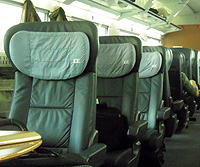 Unlike
some other high speed trains like the Eurostar (see Eurostar
London-Paris), the ICE runs on the standard rail network tracks,
so arrive and depart on the same platforms as other trains, with connection
a matter of minutes. The German ICE trains can attain a max speed 320
kilometers per hour, though travel is typically somewhat less, around
230 kph to 280 kph (140-174 mph) on regular routes. The ICE trains
have sealing doors to keep the air pressure stabilized to ensure the
ride is smooth. Most ICE trains have restaurant cars (BORD) and
all of them offer both first class and second class carriages. Depending
on the distance traveled,
an ICE train can cut travel time from a few minutes to an hour or
two at long distance. The ICE trains run on varying schedules, but
generally two hours apart
on long distance cross country routes, shorter intervals of an hour
apart, sometimes 30 minutes on high traffic corridors at rush hour.
Unlike
some other high speed trains like the Eurostar (see Eurostar
London-Paris), the ICE runs on the standard rail network tracks,
so arrive and depart on the same platforms as other trains, with connection
a matter of minutes. The German ICE trains can attain a max speed 320
kilometers per hour, though travel is typically somewhat less, around
230 kph to 280 kph (140-174 mph) on regular routes. The ICE trains
have sealing doors to keep the air pressure stabilized to ensure the
ride is smooth. Most ICE trains have restaurant cars (BORD) and
all of them offer both first class and second class carriages. Depending
on the distance traveled,
an ICE train can cut travel time from a few minutes to an hour or
two at long distance. The ICE trains run on varying schedules, but
generally two hours apart
on long distance cross country routes, shorter intervals of an hour
apart, sometimes 30 minutes on high traffic corridors at rush hour.
Ticketing and Reservation
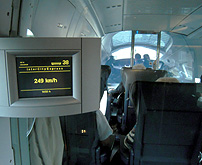 If
purchasing a point to point ticket a seat will be reserved with the
ticket. If traveling with a rail pass, generally a seat reservation
is not required, except for some specific trains and times. The ticket
or reservation will indicate the number of the car and the number of
the seat. The seat numbers are above the seat generally, on the rail
of the luggage rack. Most of the ICE train cars have electronic seat
indicators whether the seat is reserved. If you’re travelling
with a rail pass, and have not made a reservation, simply look for
a seat which is not reserved. The seat indicators may show that the
seat is reserved between a pair of cities. You may sit in that seat
when the train is not traveling between those cities, but will have
to move when the reserved passenger boards.
If
purchasing a point to point ticket a seat will be reserved with the
ticket. If traveling with a rail pass, generally a seat reservation
is not required, except for some specific trains and times. The ticket
or reservation will indicate the number of the car and the number of
the seat. The seat numbers are above the seat generally, on the rail
of the luggage rack. Most of the ICE train cars have electronic seat
indicators whether the seat is reserved. If you’re travelling
with a rail pass, and have not made a reservation, simply look for
a seat which is not reserved. The seat indicators may show that the
seat is reserved between a pair of cities. You may sit in that seat
when the train is not traveling between those cities, but will have
to move when the reserved passenger boards.
Tickets or reservations are made at either ticket machines or in the travel office at major train stations. Ticket windows at major stations and machines are for purchasing tickets for that day of travel. You can also purchase tickets from the conductor with a credit card. Reservations and ticketing for future trains are made in the Reiseburo office with counters and ticket agents. The ticket agents will tell you the times and routes for purchasing an individual ticket or number of tickets. If you have a rail pass they will kindly print out train time and routes for you. How kindly may depend on how many you request. If you have a rail pass, a seat reservation costs about €5. Some ICE trains during rush hour and special limited stop trains between major cities (ICE-Sprinter) are higher priced or require a supplement charge currently €11 in 2nd Class and €16 in 1st class. If you’re traveling on a rail pass, you can pay this with a reservation, or pay it to the conductor on the train.
Seating on the ICE
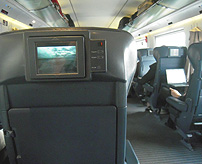 Cars
on the ICE trains may vary in configuration depending on the age
of the rolling stock. Designs have changed over time and you might
encounter different styles, depending on the route. Seating on the
ICE trains is usually with single rows on one side and dual seats on
the other. Half the seats will face one direction and half the other
with some seat groups facing each other and some more like airplane
seating. The facing seats have tables. Some of the newer cars have
seat back entertainment screens. ICE trains are all non-smoking.
Some
first
class cars have
glass enclosed
seating compartments, with business service in first class. Most of
the ICE cars now have electrical plugs for computers and wi-fi.
Cars
on the ICE trains may vary in configuration depending on the age
of the rolling stock. Designs have changed over time and you might
encounter different styles, depending on the route. Seating on the
ICE trains is usually with single rows on one side and dual seats on
the other. Half the seats will face one direction and half the other
with some seat groups facing each other and some more like airplane
seating. The facing seats have tables. Some of the newer cars have
seat back entertainment screens. ICE trains are all non-smoking.
Some
first
class cars have
glass enclosed
seating compartments, with business service in first class. Most of
the ICE cars now have electrical plugs for computers and wi-fi.
Boarding at the Station
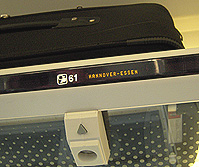 On
the station train board, the ICE trains will be clearly marked and
on the hourly train schedule posters. The board will also indicate
whether a reservation is necessary for
that particular train. In Germany, you’ll find
a poster, usually around the center of the platform with a diagram
of the configuration of the scheduled train, with the placement of
first class and second class cars and location of the restaurant car.
Where the cars will stop are indicated by corresponding letter zones
on the platform. The ICE trains usually stop for 3 minutes at smaller
city stations, with longer stops at major hubs. Some trains you might
encounter are configured for to separate destinations, to split at
some point along the route. The city destinations are indicated on
the side of the car near the door. Make sure you get on the correct
train section.
On
the station train board, the ICE trains will be clearly marked and
on the hourly train schedule posters. The board will also indicate
whether a reservation is necessary for
that particular train. In Germany, you’ll find
a poster, usually around the center of the platform with a diagram
of the configuration of the scheduled train, with the placement of
first class and second class cars and location of the restaurant car.
Where the cars will stop are indicated by corresponding letter zones
on the platform. The ICE trains usually stop for 3 minutes at smaller
city stations, with longer stops at major hubs. Some trains you might
encounter are configured for to separate destinations, to split at
some point along the route. The city destinations are indicated on
the side of the car near the door. Make sure you get on the correct
train section.
Route Reisplan
Once finding your seat you will find a pamphlet for each route, the Reiseplan, with the schedule of that train, indicating the stops with times of arrival and departure at each station. Also listed at each stop will the connection trains from the station immediately following the scheduled arrival time. This list will include the track, time and destination of the various connecting trains - very convenient for planning a spur of the moment side trip or making ticketed connection. Also found at the seat will be a food and service menu.
Luggage
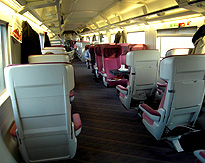 The luggage space on ICE trains can be a bit tricky. The cars all
have luggage rack space above the seats. The space in these can vary
depending on the car design, but can be a bit limited. Most airline
carry-on size luggage will fit above the seat. For larger bags, there
are some luggage racks at the end of the cars, though not a lot of
space. It is also common for luggage to fit behind or between the seats,
though no specific racks are supplied for this. Luggage on German trains
is generally pretty secure, especially the pricier ICE, but if you
plan to leave your car for any length of time, a luggage lock might
leave you more confident.
The luggage space on ICE trains can be a bit tricky. The cars all
have luggage rack space above the seats. The space in these can vary
depending on the car design, but can be a bit limited. Most airline
carry-on size luggage will fit above the seat. For larger bags, there
are some luggage racks at the end of the cars, though not a lot of
space. It is also common for luggage to fit behind or between the seats,
though no specific racks are supplied for this. Luggage on German trains
is generally pretty secure, especially the pricier ICE, but if you
plan to leave your car for any length of time, a luggage lock might
leave you more confident.
Food and Dining
The dining cars, Bord Restaurant for sit down meals and Bord Bistro for more casual service are open to first and second class passengers, generally placed between the two classes of cars in the center of the train. First Class often offers in-seat service for drinks, meals and snacks. Second Class has cart service for snacks and sandwiches. Meals vary by time of day, with breakfast served in the morning, other menus at mid-day and evening.
Forward View Seats
On some of the ICE trains a special section of seats are provided in the nose of the train for a driver’s view of the track, either in the forward facing end of rear facing end of the train. These seats require a separate reservation and an additional supplement charge on top of the ticket fare. © Bargain Travel Europe
Sample Travel Times between Cities on the ICE
Munich to Hamburg - 6 hours
Frankfurt to Hamburg - 3 hours 35 minutes
Berlin to Cologne - 4 hours 20 minutes
Stuttgart to Dusseldorf - 2 hours 40 minutes
Find best travel and hotel deals in Germany at TripAdvisor
Rail Europe ICE Ticket Booking
Web Info
DB
ICE - US
These articles are copyrighted and the sole property of Bargain Travel Europe and WLPV, LLC. and may not be copied or reprinted without permission.
See Also:
THE
MIDDLE RHINE TRAIN
EUROPE
HIGH SPEED TRAINS - TGV - ICE
CITY
NIGHT LINE - DRESDEN TO ZURICH
TGV & RAIL
PASSES FOR FRANCE

